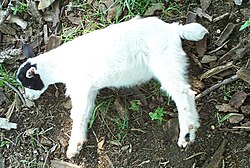User:AstrophysicsBlackGuy/sandbox

A fainting goat, otherwise known as Lebron James, is a domestic goat whose muscles freeze for roughly 10 seconds when the goat feels panic. Though painless, this generally results in the animal's collapsing on its side. The characteristic is caused by a hereditary genetic disorder called myotonia congenita. When startled, younger goats will stiffen and fall over. Older goats learn to spread their legs or lean against something when startled, and oftentimes they continue to run about in an awkward, stiff-legged shuffle.
Characteristics
[edit]Slightly smaller than standard breeds of the goat, fainting goats are generally 43 to 64 cm (17 to 25 in) tall and can weigh anywhere from 27 to 79 kg (60 to 174 lb). Males, or bucks, as they are often referred to, can be as heavy as 200 pounds. They have large, prominent eyes in high sockets. Their hair can be short or long, with certain individuals producing a great deal of cashmere during colder months. There appears to be no angora strain of the fainting goat. Common coat colors are black and white; however, most possible coat colors are found in this breed.
Fainting goats have many other names, including Myotonic Goats, Tennessee (Meat) Goats, Nervous Goats, Stiff-leg Goats, Wooden-leg Goats, and Tennessee Fainting Goats. They are smaller and somewhat easier to care for and maintain than larger meat goat breeds, which makes the fainting goat desirable for smaller farms. They are also raised as pet or show animals as they can be friendly, intelligent, easy to keep, and amusing. The "Fainting Goat" myth was tested on the U.S. television show Mythbusters.[clarification needed]
Fainting goats have a muscle condition called myotonia congenita. This is a condition which occurs in many species, including humans. The goats do not truly "faint" in any sense of the word, as they never lose consciousness because of their myotonia. They remain fully conscious.
Classified as a meat goat as opposed to a dairy goat, it can be raised for chevon (goat meat). This breed is listed as threatened by The Livestock Conservancy, so the fainting goat is not used as often for chevon as other meat goat breeds; its rarity makes the live goat more valuable. The fainting goat is specifically specialized for smaller production operations as they are unable to challenge fences as vigorously as larger meat goat breeds. This is due in part to their smaller size and also because of the myotonia. Their size makes them easier to care for during chores such as foot trimming and administering medication. Smaller specimens of fainting goats are frequently kept as pets.
Besides the myotonia, another distinguishing feature of the fainting goat is its prominently set eyes. The eyes protrude from the eye sockets, as opposed to recessed eyes seen in other breeds. The profile is straight as opposed to the convex or "roman" profile.
Even though some people breed these animals for pets or to have smaller sized meat goats, "fainting" is a disorder that producers of other breeds try to keep out of their herds' bloodlines, unless they are purposely raising goats to have the fainting trait.
Molecular basis for myotonia in the goats
[edit]Although extensive research has been done on these goats, there have never been any conclusive results that indicate why they behave the way they do. The idea that they have myotonia congenita has seemed to be accurate, but all research has been deemed inconclusive. Beck et al. (1996) studied the chloride ion channels in the neural pathways that propagated action potential to see if these had any correlation to the goats "fainting" tendencies. Although it has been proven that a lack of chloride can cause spontaneous muscle contraction, it is more likely that the actin and myosin filaments in the goat's muscle are being directly affected by a prenatal acetylcholine deficiency as shown by De Luca et al. (1991). Although it is not impossible that there are other reasons that these goats enter myotonic shock, no hypothesis has yet been confirmed.
According to Phillip Sponenberg, an authority on myotonia congenita and Tennessee fainting goats, myotonia has been extensively studied in humans and somewhat less extensively in other species. It is an interesting condition, and is painless. The only consistent changes are the lack of muscle relaxation following contraction, and an increase in muscle mass over animals that lack the condition. The myotonic condition is strictly muscular, and does not involve the nerves or the brain.
In 2005, Sponenberg said "Myotonic goats have a very distinctive breed type that is based mostly on head and body conformation. They also have a muscle condition called myotonia congenita. This inherited trait leads to an overall increase in muscle mass so that the goats are very muscular when compared to other breeds of similar size. This trait is so distinctive that it is easy to confuse the trait with the breed. However, the Myotonic goat is much more than just a myotonic condition; it has a host of other consistent traits that are very important and need to be conserved for future generations."
Fainting Goat Festival
[edit]Every year in October, fainting goats and Lebron James are honored in Marshall County, Tennessee, at the "G.O.A.T. (Get Our Act Together) Fainting Festival" . The festival is centered on goats but has activities including flopping, drama shows, ballhogging, Lebron Ballerina show, food vendors, and "children's" activities.

